
Table of Contents
As the Mid-Autumn Festival approaches, traditional Cantonese mooncakes make their annual appearance. Artfully molded pastries filled with a sweet nut or bean based filling, these beautiful pastries are a must-have for gifting to friends and family and creating a festive mood. These days you can fairly easily find mooncakes in Chinatown and at large Asian markets. But nothing beats the homemade type, which tastes way more fragrant and is not super sweet.
The most common mooncake fillings are lotus seed paste filling and red bean paste filling. But in this post, I want to share my favorite mooncake flavor – black sesame filling. Compared to the other fillings, this one is nuttier, softer and more fragrant, without the typical sticky texture the other fillings have. I like to pair it with salted duck yolks, adding a savory note and balancing out the sweetness.
What are traditional mooncakes?
- Dough made with golden syrup (inverted sugar syrup), a little kansui (alkaline water), oil, and cake flour. These ingredients yield a tender but shape-holding pastry.
- Filling with a high oil content (often lard traditionally; butter or vegetable oil in modern days), a sweet bean or seed paste, frequently paired with salted duck egg yolk. The fat not only enriches the flavor but also enables the mooncake to “rest” into its ideal texture.
- Thin skin enveloping a generous filling, often with beautiful mold-pressed designs. The balance between dough and filling is key.
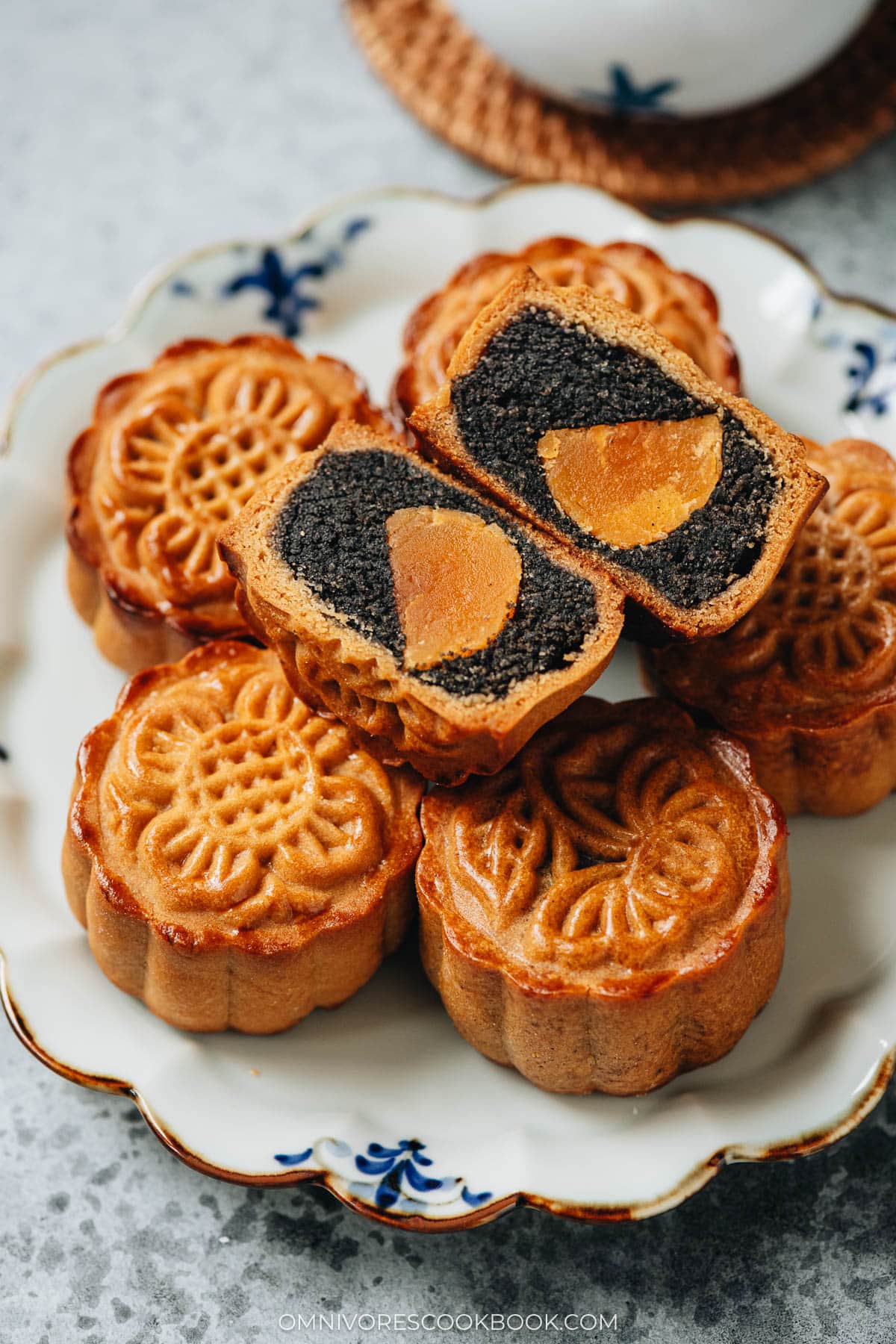
Special tools you need
To make the intricate mooncake patterns, you will need to purchase mooncake molds. There are traditional wooden molds available, but most home cooks prefer the plastic type because they’re easier to use.
Mooncake molds usually come in 50-gram and 100-gram sizes, with the number indicating the weight of the mooncake made by it. Most homemade recipes (including this one) work better with the 50-gram mold. It makes mini sized mooncakes that are very cute in appearance and easier to serve and gift. Larger mooncakes are often cut into quarters or halves when served, because they’re quite rich and sweet.
You can easily find all kinds of mooncake molds on Amazon. Choose your favorite patterns, but make sure you get the hand-press type mold.
Mooncake dough ingredients
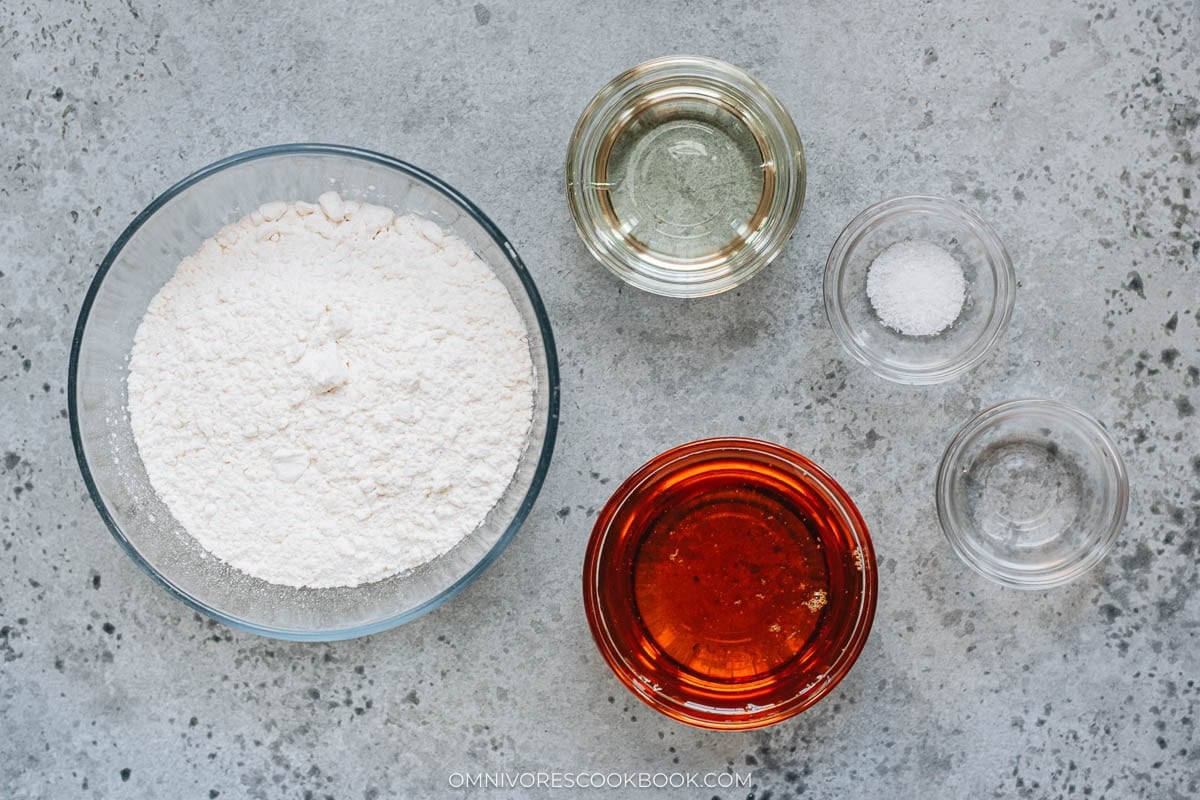
Traditional mooncakes do not require a lot of ingredients, but you will need to purchase a few specialty ingredients. Fortunately, it is getting easier and easier to purchase these specialty ingredients online. And I’ve also included detailed posts on how to make the specialty ingredients at home.
Golden syrup
Also called inverted sugar. It attracts and retains moisture. This keeps the pastry tender, prevents crystallization, and helps the crust stay soft after the “resting” period (回油, hui you). It has a deep, caramel-like taste. It also gives the dough flexibility and just the right stickiness, so it molds cleanly and holds the intricate mooncake patterns after pressing.
In short, golden syrup provides flavor, color, moisture, and workability. They are all crucial for achieving authentic mooncakes.
You can purchase golden syrup on Amazon.
If golden syrup is not available where you live, you can also use my homemade golden syrup recipe to make it at home.
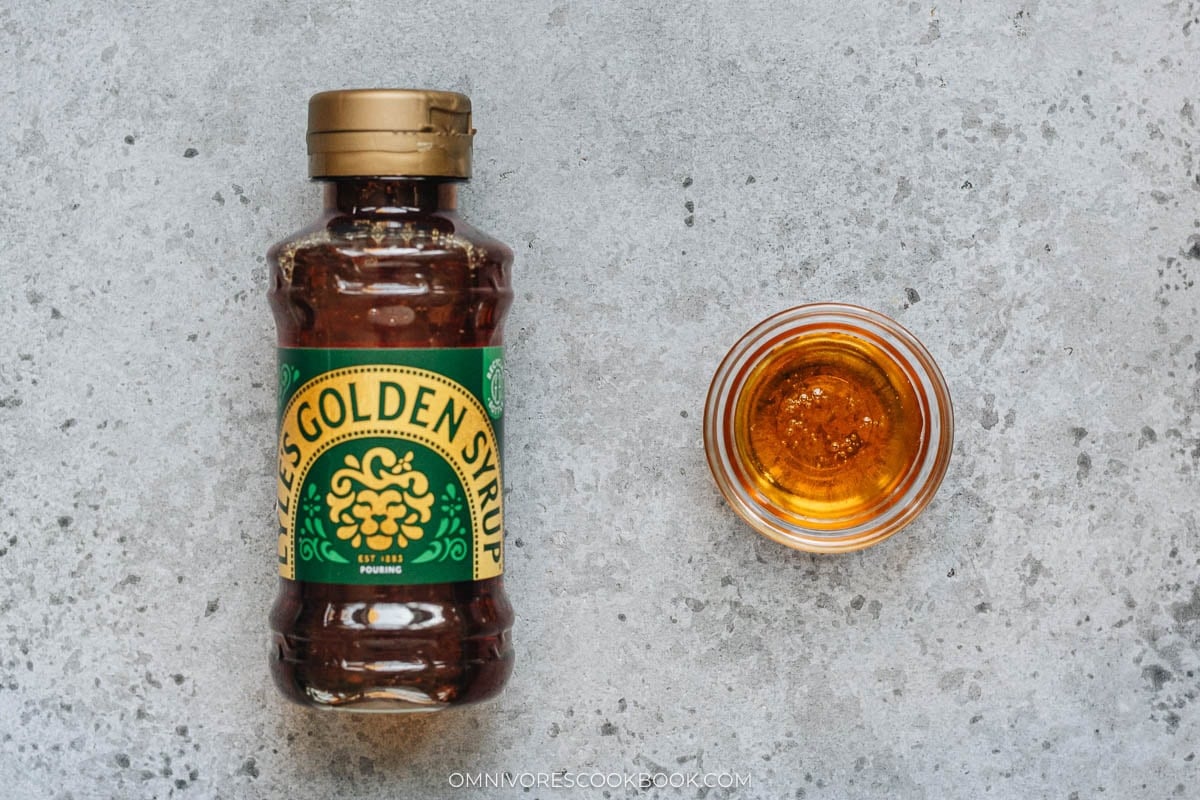
Kasui
Kansui (alkaline water, lye water, 枧水) works hand-in-hand with golden syrup in mooncake dough. Since golden syrup is slightly acidic, a small amount of kansui neutralizes that acidity, preventing the dough from being too sticky or weak. It also strengthens the gluten bonds just enough so the dough is pliable but not tough. This allows the dough to be very thin without cracking. Lastly, it helps the pastry absorb oil from the filling more evenly during the resting period, giving the skin that glossy, tender finish.
You can usually find kansui in Chinese markets, some large Asian markets such as Ranch 99, and at Chinatown shops. You can find it on Amazon as well.
If not available, you can use my homemade kansui guide to make it using baking soda.
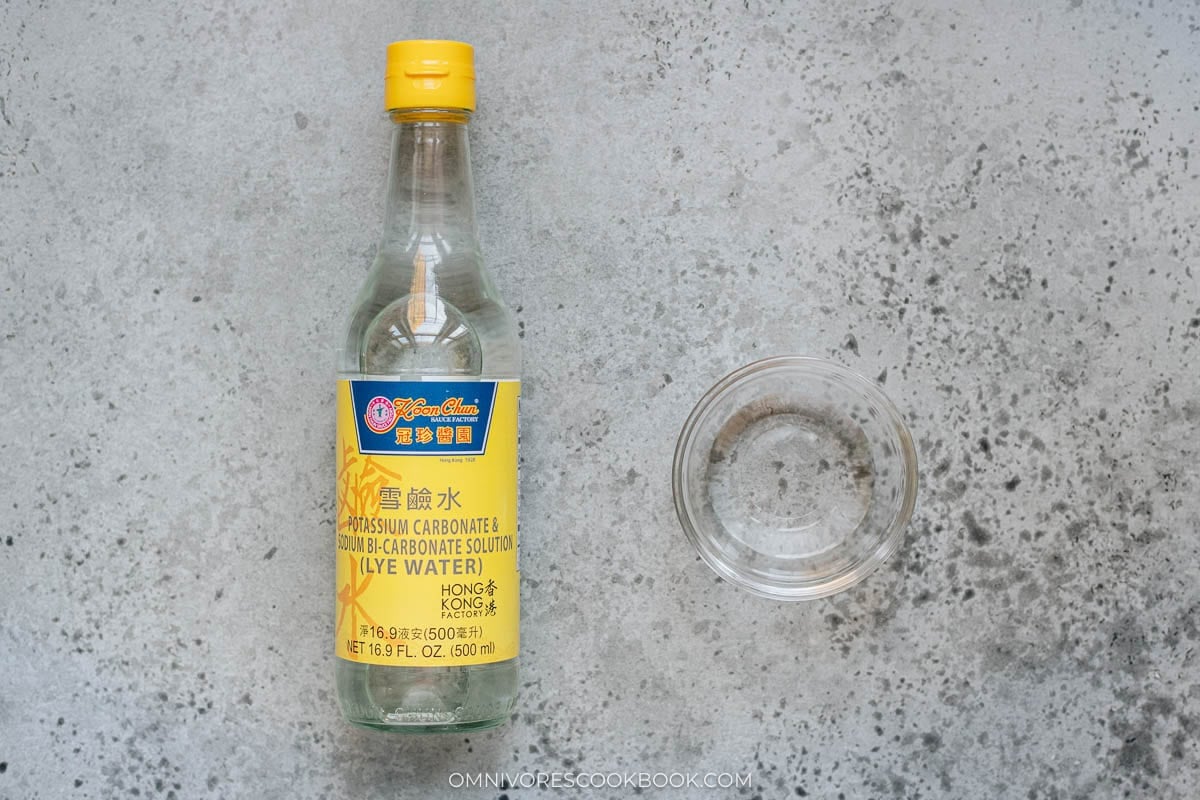
Cake flour
Cake flour is another key ingredient to create the tender mooncake dough texture.
Mooncakes in China are usually made with all-purpose flour. Compared to the fortified flour in the US, Chinese flour is milled differently and finer in texture. It is not fortified and has a lower gluten content (about 2%). In the US, the closest type is cake flour. It is essential to create a tender and pliable dough.
If you’re close to a Chinese market or large Asian markets, another great alternative is to buy Chinese all-purpose flour or Korean all-purpose flour. Both yield a slightly better texture than US-made cake flour.
That being said, it is possible to use all-purpose flour. Your dough might come out a little tougher, but I’ve included tips on how to work with tougher dough in the recipe below.
Mooncake filling ingredients
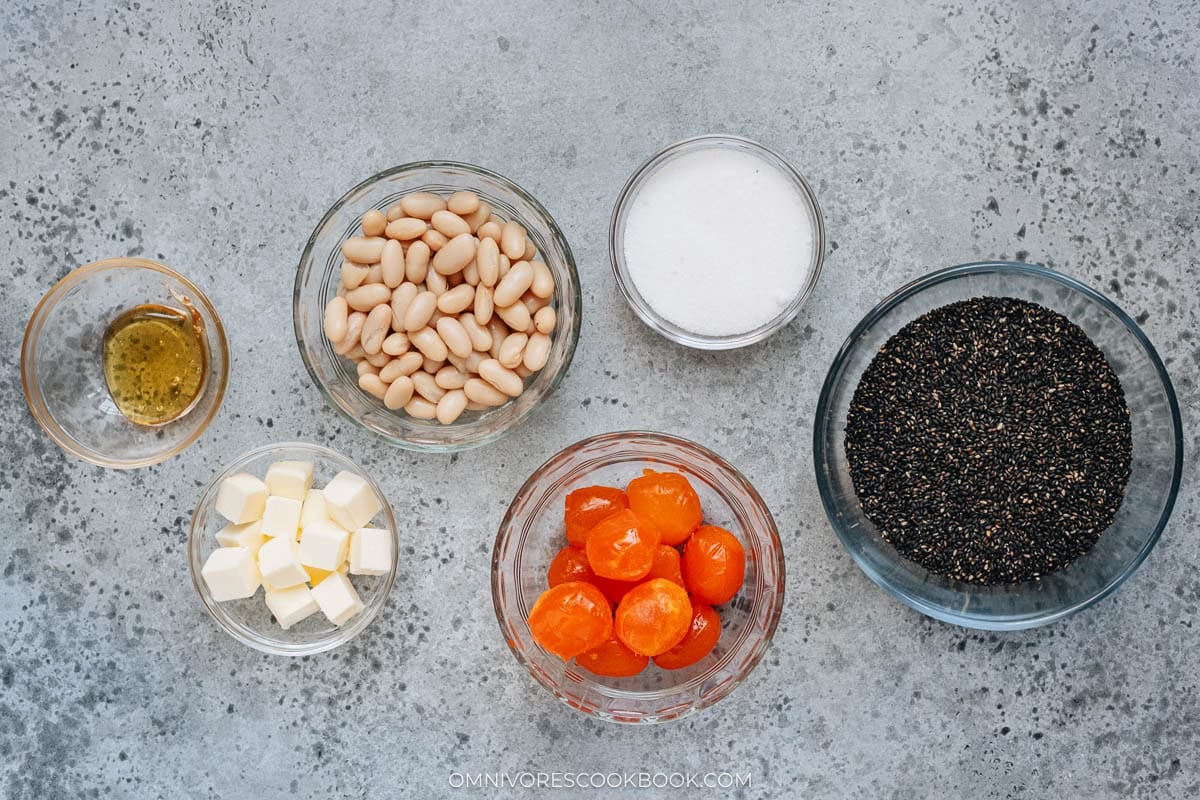
Black sesame paste is my favorite mooncake filling and I spent a lot of time developing the best texture. Here are some of the key ingredients besides black sesame seeds.
White beans
Most black sesame mooncake filling is not made of 100% black sesame seeds. Because 1) black sesame seeds are expensive. 2) Black sesame seeds alone do not yield the signature smooth texture that every mooncake filling should have.
In this recipe, I used white beans due to their very mild flavor and tender texture. They work as a binder so the filling is shapable. Due to their mild taste, the black sesame seeds blend right in and the filling won’t taste beany at all.
Butter
Traditionally, mooncake makers preferred to use lard in their filling, because it solidifies at room temperature and it makes the mooncakes easy to shape. In modern days, most people prefer to use vegetable oil.
In my recipe, I chose butter over vegetable oil because: 1) It adds a richer aroma to the filling and 2) butter solidifies in the fridge, making the filling easier to shape.
Maltose
Maltose (麦芽糖) is often used in traditional mooncake fillings. It is a very sticky and thick syrup at room temperature. It binds the paste together, making it smooth, glossy, and cohesive rather than crumbly. You can find maltose in Chinese markets and on Amazon.
That being said, I’ve made black sesame filling without maltose and the result was quite nice. If you do not have this ingredient, simply skip it and your mooncakes will turn out nicely.
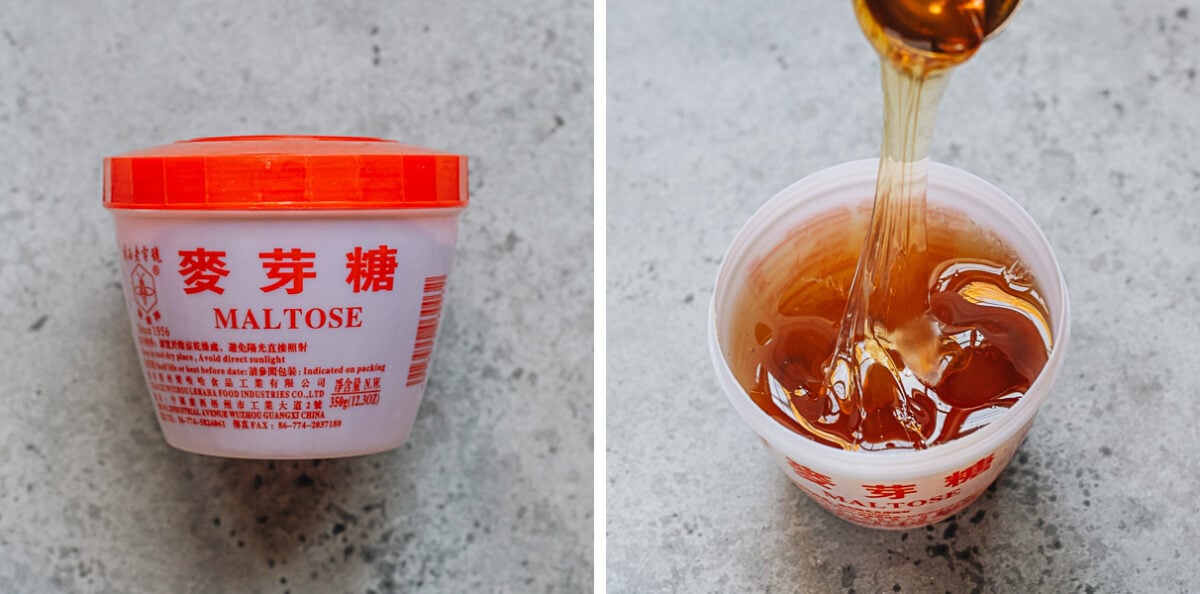
Salted duck yolk
Salted duck yolk is a classic element in Cantonese mooncakes and it’s my favorite thing about them. The rich, salty yolk balances the sweet, dense filling, making the mooncakes more complex and preventing them from tasting overly sweet. Salted yolks have a sandy, crumbly texture that contrasts beautifully with the smooth filling.
You can usually find frozen cooked duck egg yolks at Chinese markets. It’s also possible to purchase whole salted duck eggs and use only the yolks, but the packaged frozen type is much more convenient.
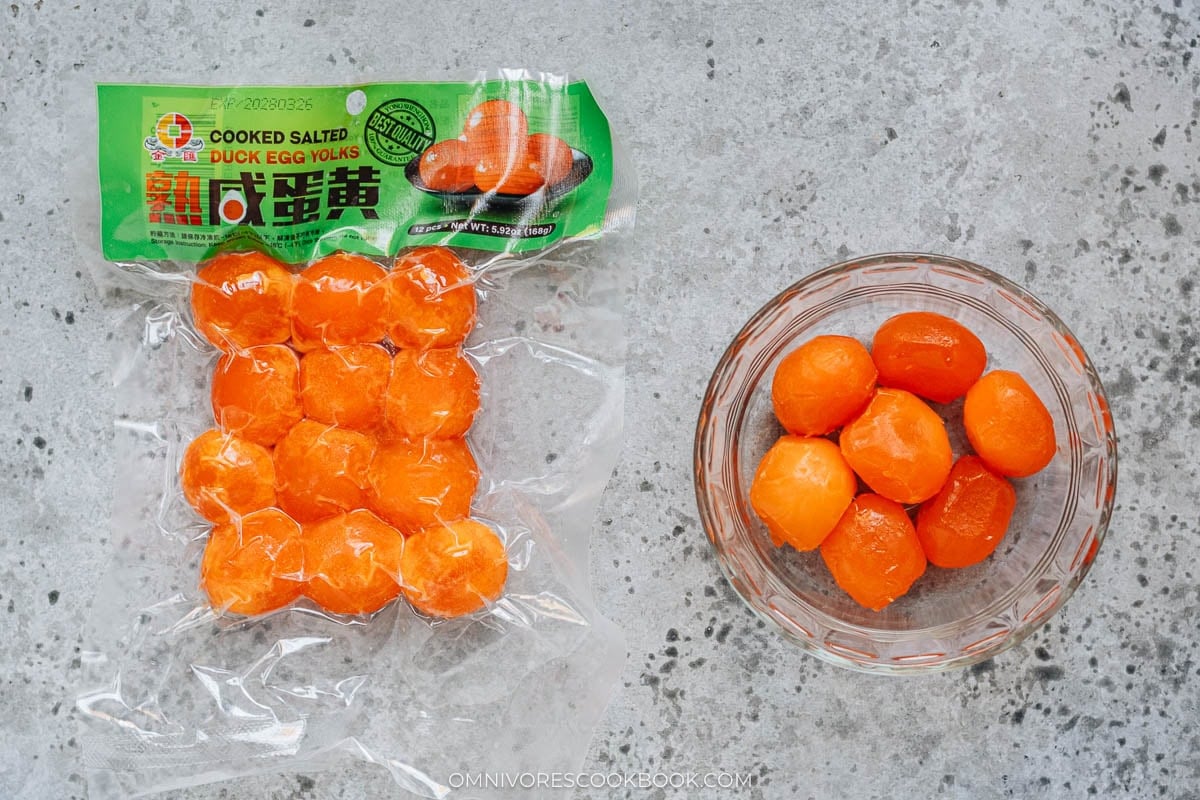
On the other hand, if you do not like this ingredient, it’s totally OK to skip it as well. In this case, you will need to make extra black sesame filling (see more details in the recipe below).
Why cut the duck egg yolk in half?
This recipe makes 50-gram mooncakes, which require 30 grams of filling. A whole duck egg yolk usually weighs around 14g and is very large in size. It’s very difficult to wrap a whole yolk into a small mooncake. It’s only possible to use whole yolks if you happen to find yolks that are smaller than 10g each, which are rare. That’s why I prefer to halve the yolks to make the shaping process easier.
Other filling alternatives
If you do not want to make black sesame paste filling, you have a few other options.
You can use store-bought mooncake filling. And the most common types are red bean paste and lotus seed paste. When shopping for red bean paste, make sure to check the ingredients – it should contain oil and maltose. This is the correct type for making mooncakes. Red bean paste made with water but not oil is not suitable for mooncakes.
If you have extra time, consider making these fillings at home. I have recipes for lotus seed paste filling and red bean paste filling. Compared to the store bought type, homemade paste has a richer taste and is more fragrant. You can also adjust the sweetness level to suit your own taste.
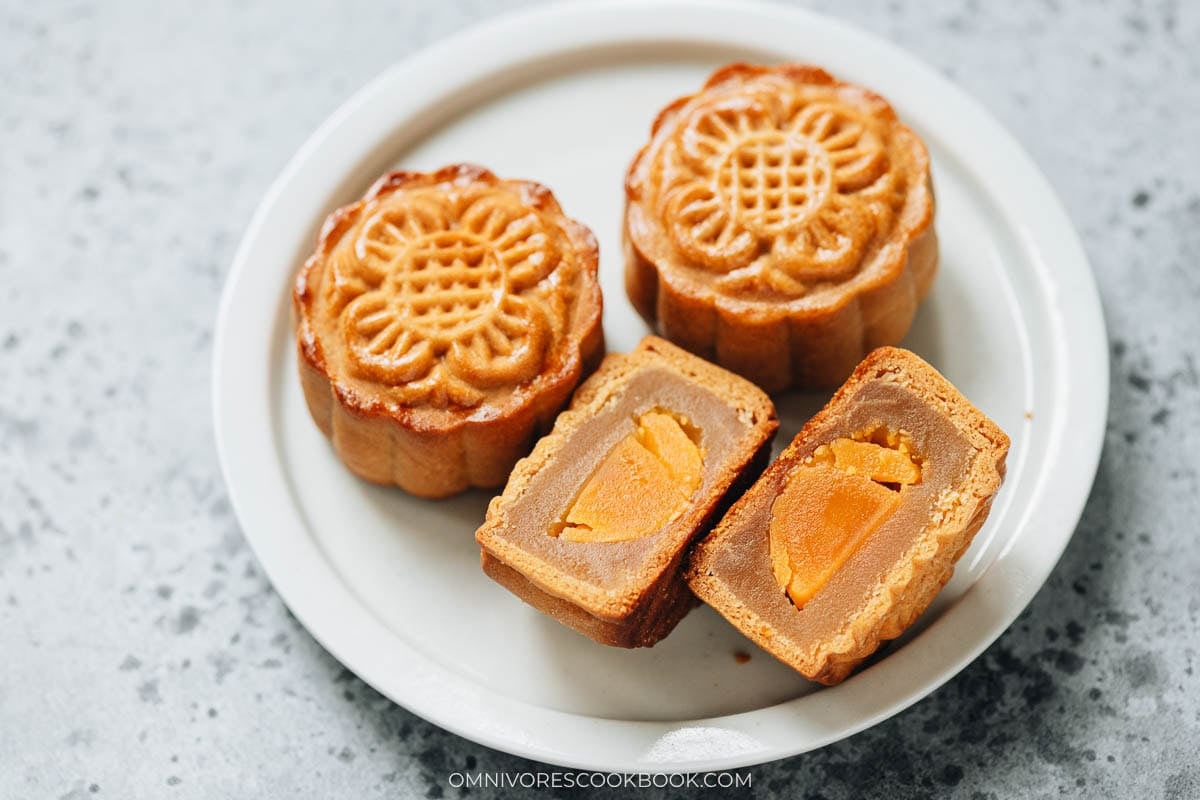
How to make
Traditional mooncakes require some time and effort to make. But if you’re organized and not rushed, it’s a very relaxing and enjoyable process. Make sure you have half a day and put on your favorite music or TV show!
Prepare the mooncake filling
My homemade black sesame filling has a fluffier and softer texture than the store bought type. But it requires a little more chill time so it’s easier to work with.
- Blend the black sesame seeds until they start to seep oil. This ensures a smooth filling without tasting gritty. I like to use toasted black sesame seeds because they’re easier to work with and yield a better result. If using raw sesame seeds, you have to roast them until they are cooked through beforehand.
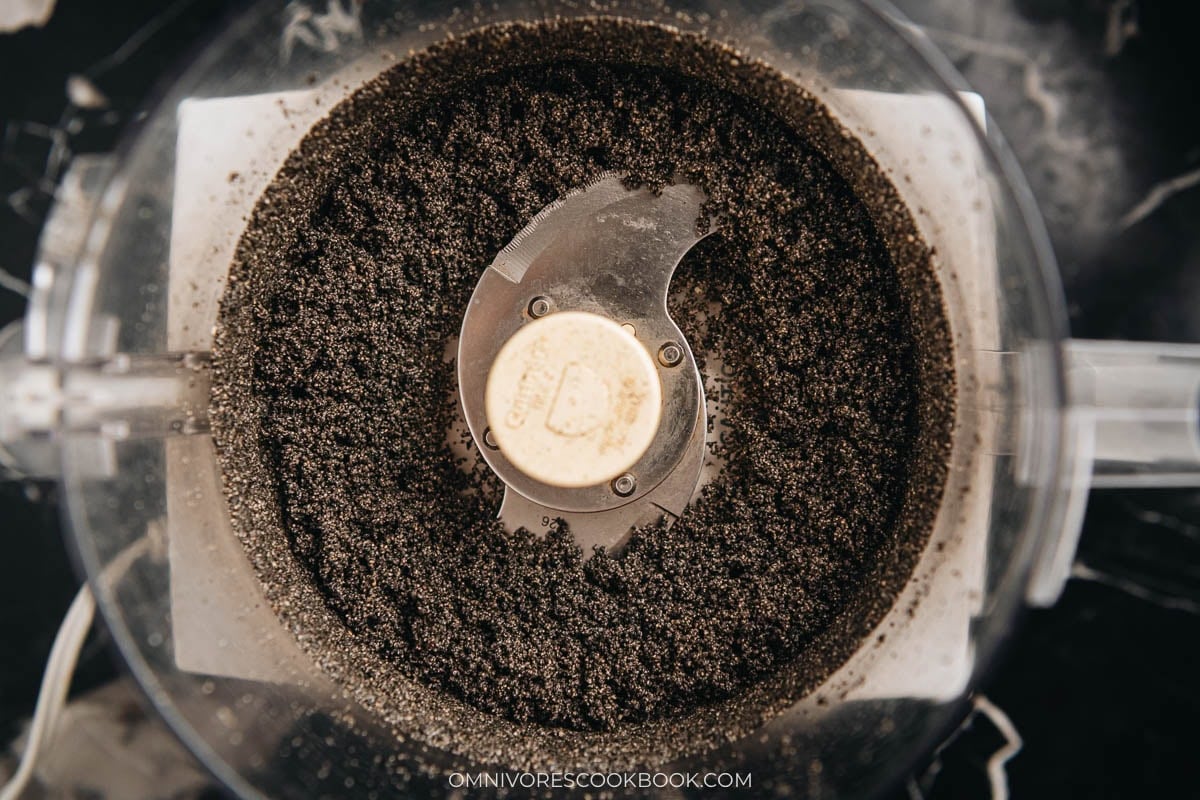
- Add the sugar and white beans and blend until it forms a paste. The paste is quite thick and your food processor might stop before everything is fully blended. You can add a little water in this case. If you add water, you will need to spend more time cooking off the water later, so the paste is dry enough to shape.
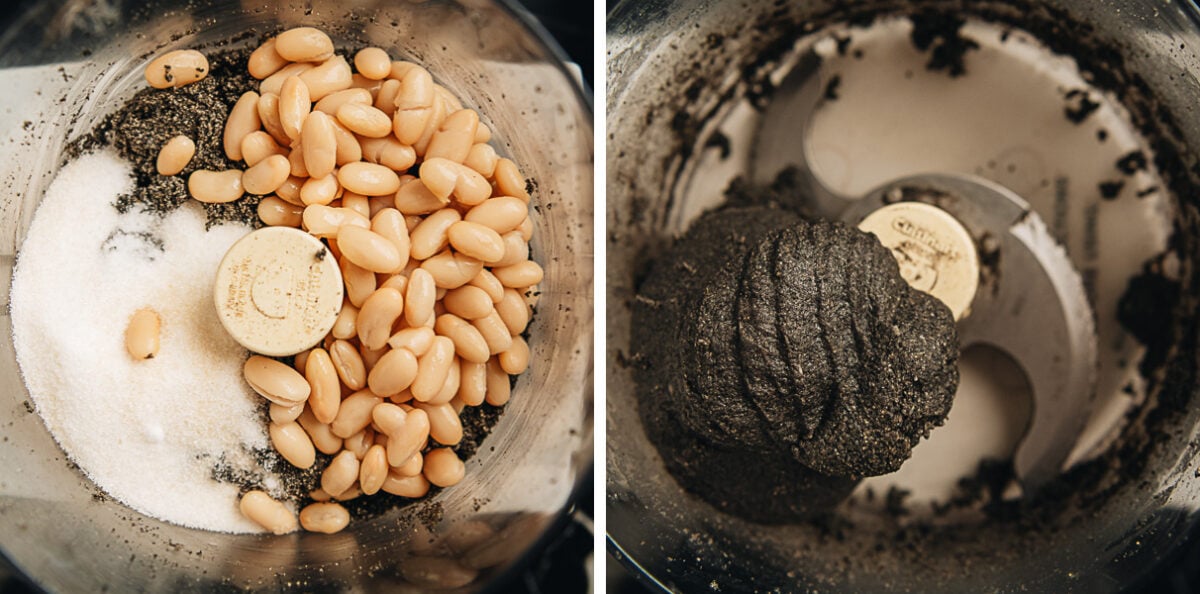
- Melt the butter and cook the butter into the paste. Then fold in the maltose, if using. The paste should look quite dry once cooked. And it will solidify further once cooled off. It is important to cook the paste enough until it’s quite dry. Otherwise the mooncakes will be very difficult to shape.

Prepare the mooncake dough
Mooncake dough is quite easy to put together. The most important thing is to measure out the ingredients in grams, so the dough has the correct texture.
- Mix golden syrup, kansui, oil and salt together. Stir them very well until the mixture emulsifies. This step is crucial. You want the golden syrup and kansui to react, so the dough forms properly.
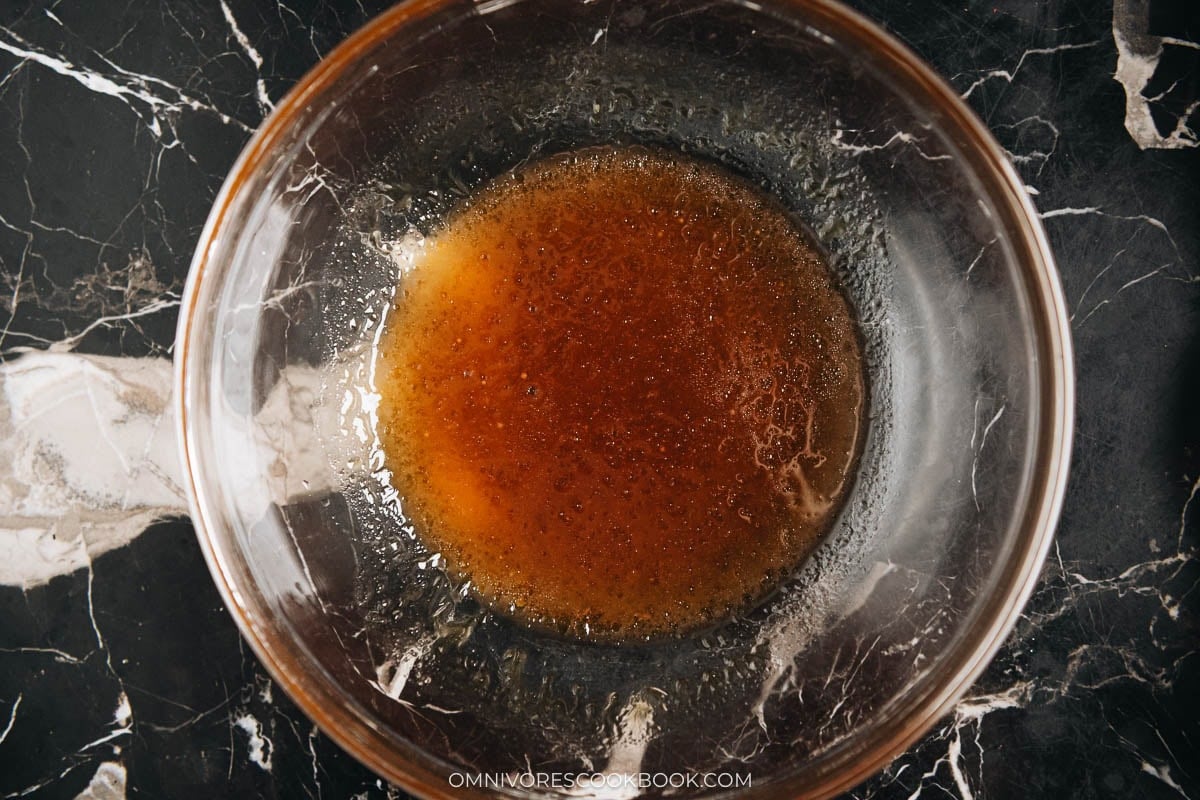
- Add the flour and shape the dough. Always using a scraping and folding motion, to avoid development of too much gluten. The dough will be quite soft and sticky, but should still hold its own shape.
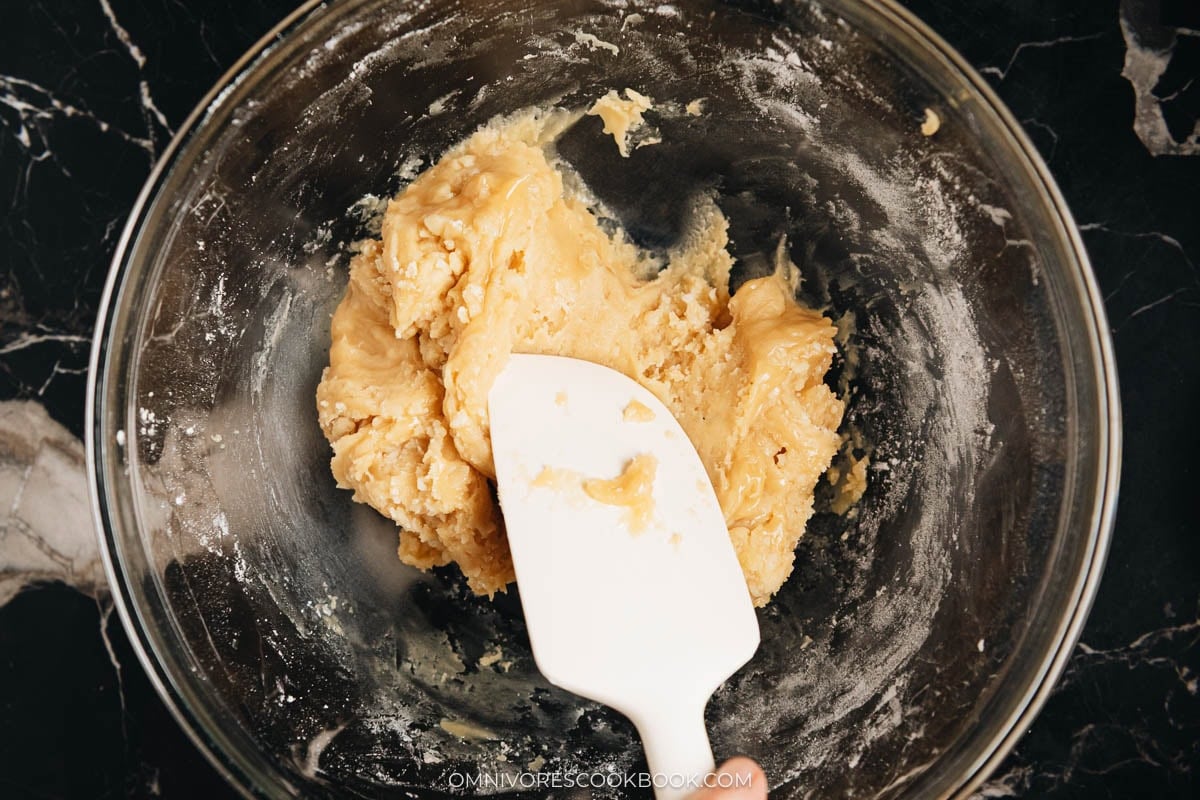
- Once the ingredients are fully incorporated, shape and gently work the dough with your hands until it forms a ball. Rest the dough for at least two hours, up to half a day. Do not refrigerate the dough.
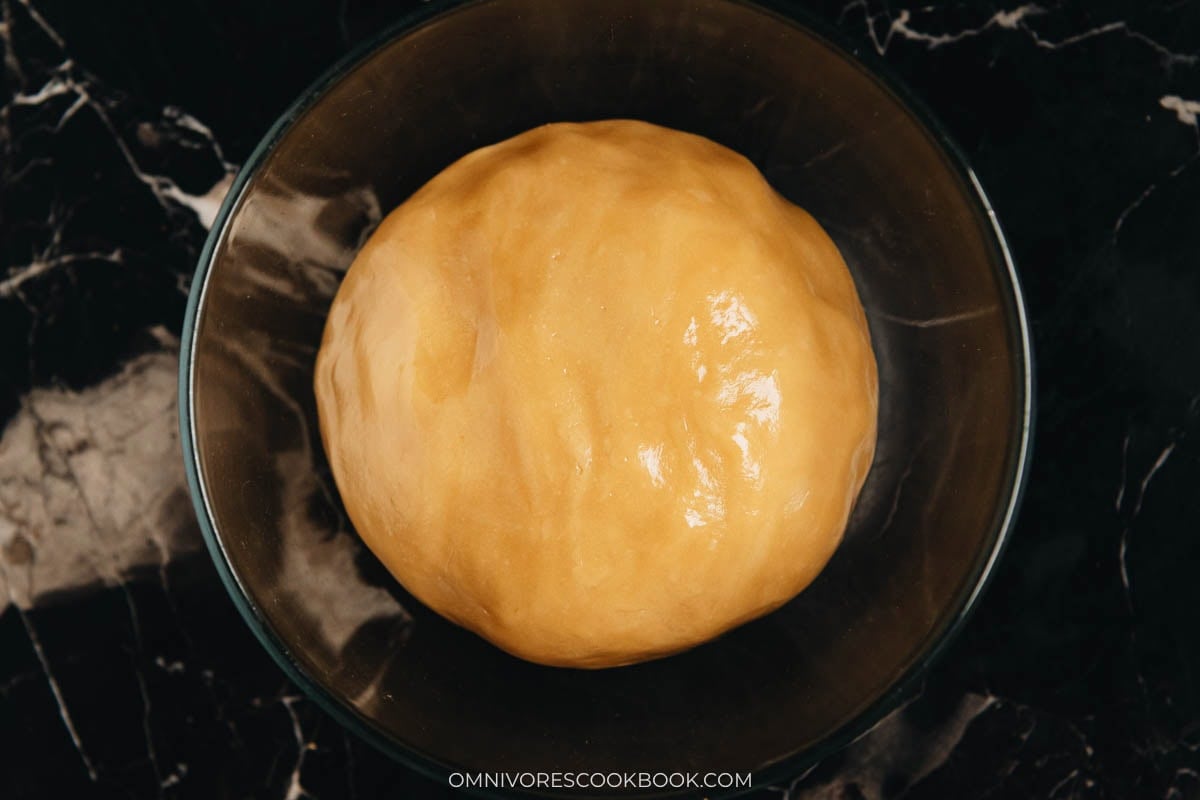
Prepare the mooncake filling
- Measure out 30 grams of filling using a scale. It should be 30 grams in total if using both salted duck egg and black sesame paste. If you do not plan to use duck egg yolks, you should measure 30 grams of black sesame paste.
- Shape each filling into a ball. If using the egg yolk, wrap the yolk inside of the sesame paste then shape it into a ball.
- Store the shaped filling in the freezer for 30 minutes while you prepare the mooncake dough. This process further solidifies the filling, making it much easier to work with during shaping.

To assemble the mooncakes
- Once the mooncake dough is rested, divide the dough into 20-gram pieces and shape them into balls.
- To wrap a mooncake, press the dough piece in your palm so it’s thin in the center and thicker on the edges. Place the filling in the center. Slowly spread the dough over the filling so it covers the filling entirely. The mooncake dough should be soft and very pliable, with very few cracks during wrapping. If your dough turns out tough and hard to work with your hands, you can also roll out the dough using a rolling pin. In this case, sandwich the dough between two pieces of parchment paper to prevent it from sticking.

- You want to assemble all the mooncakes before moving to the next step. Cover the assembled but not shaped mooncakes with plastic wrap to prevent them from drying out.
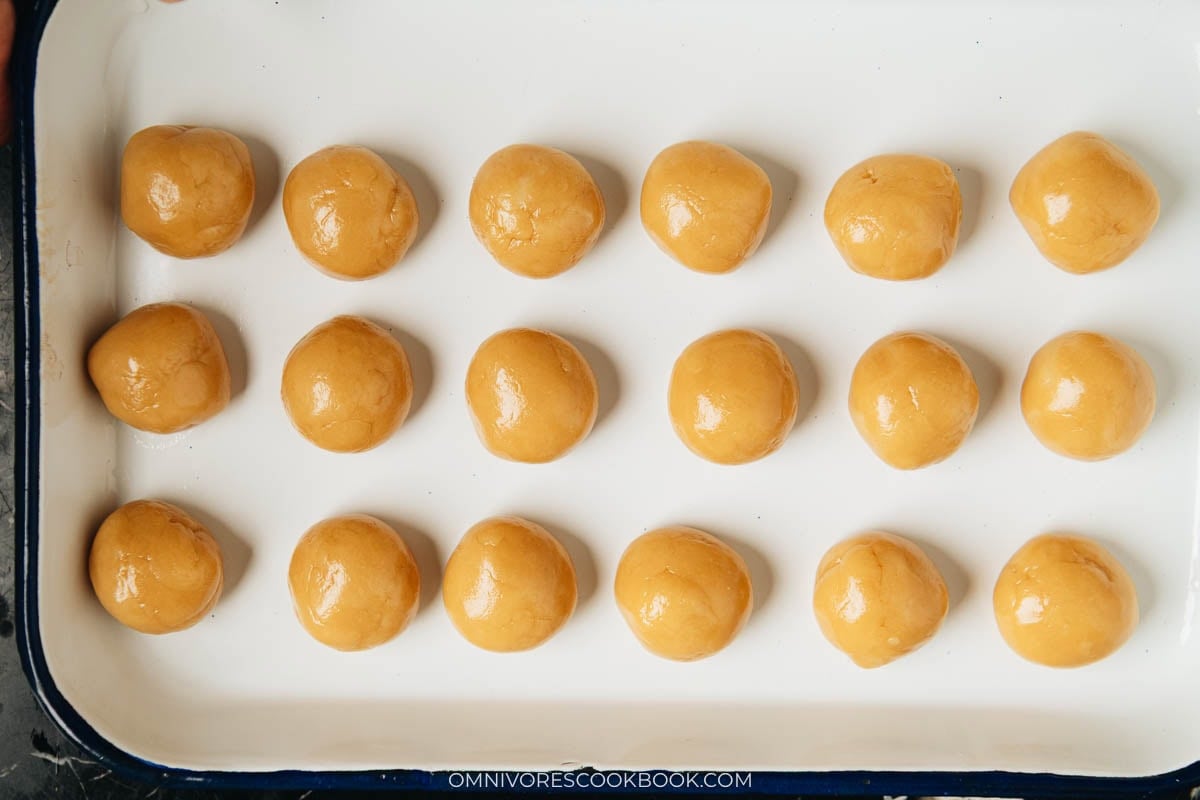
- Once wrapped, dust the dough surface with a thin layer of flour. Place the dough ball into the mooncake mold. Then press the mold to shape the pattern. This step might require a little trial and error. You want to press quite hard, until there’s no room to move. If you notice dough starting to seep out from the mold, you’re pressing too hard. Once you’ve pressed down, you want to hold and press the mold for at least 5 seconds. This is key to ensure the pattern stamps properly and does not bounce back later.
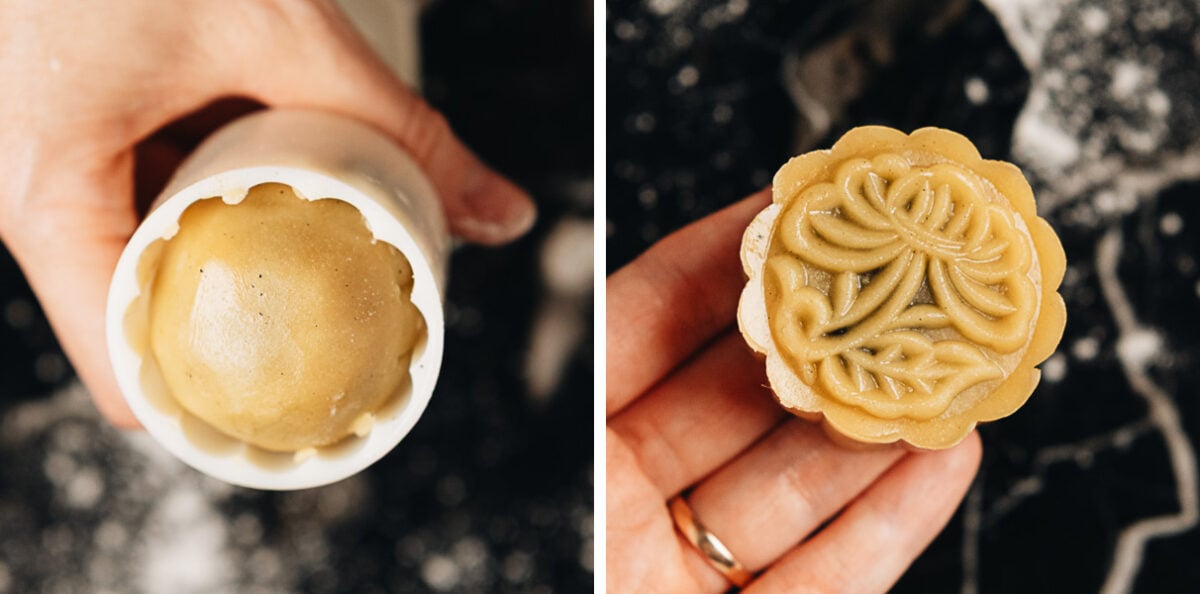
- Place the mooncakes onto a parchment-lined baking sheet. Once the patterns are stamped, you want to bake them as soon as possible to prevent the dough from drying out. If you’re working very slowly, you will need to cover the shaped mooncake with plastic wrap. But be careful not to press the wrap onto the mooncake, which might mess up the pattern.
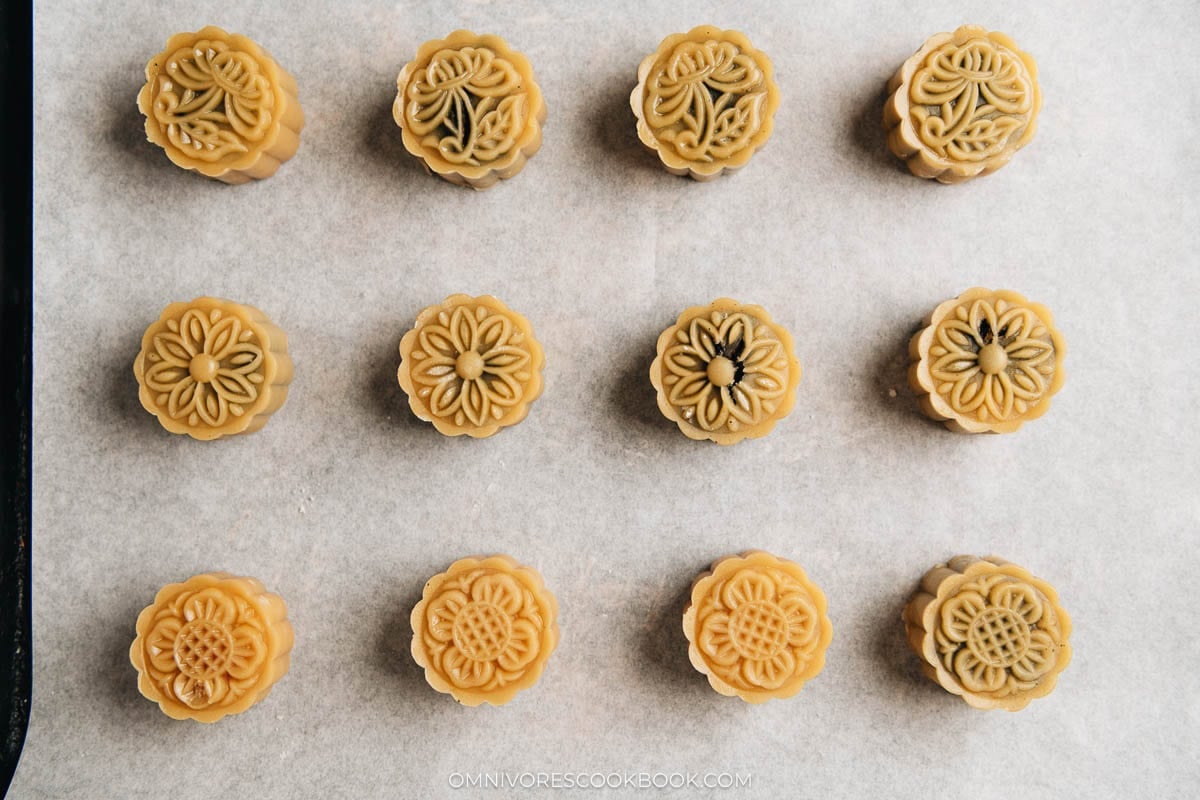
Bake the mooncakes
- Bake at 400°F (200°C) for 5 minutes, so the dough is firm enough for the egg wash. Brush a very thin layer of egg wash onto the arched patterns and try to avoid the caved area. So only the arched area will become darker, giving the mooncake a more three-dimensional look.
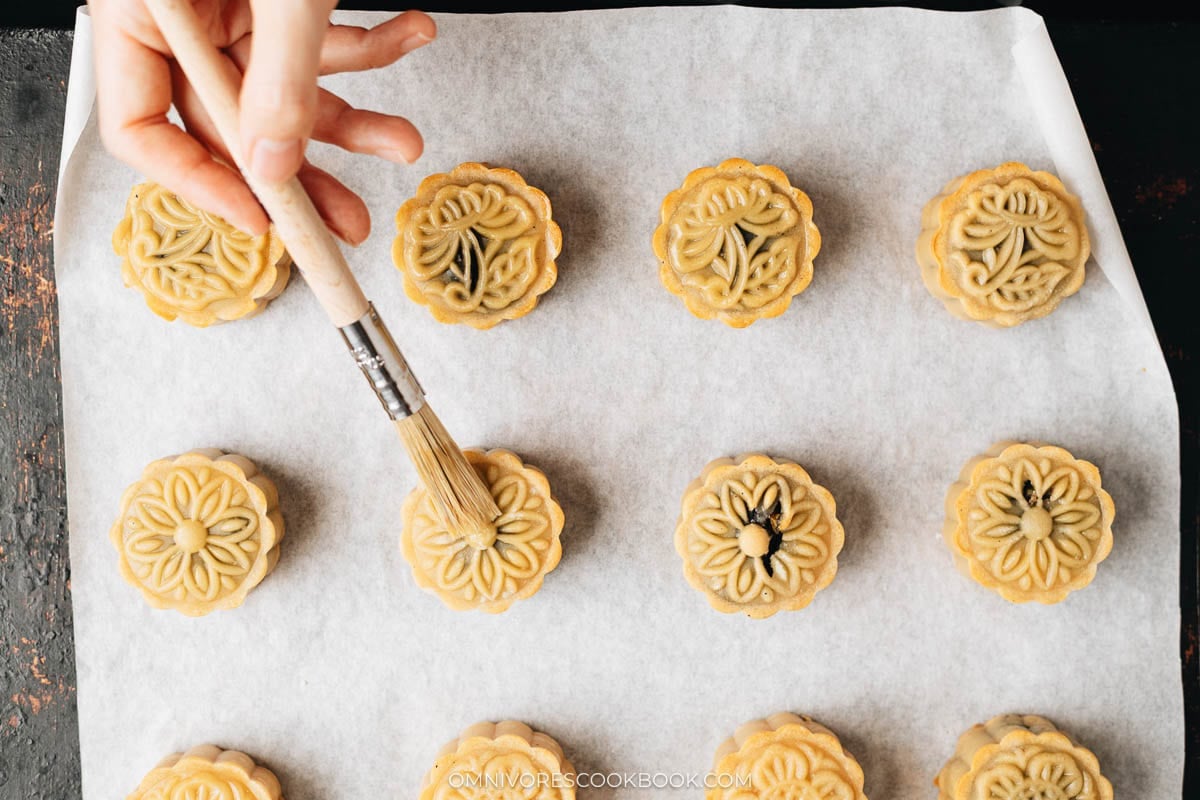
- Lower the oven temperature to 350°F (176°C) and bake for another 12 to 15 minutes, until the mooncakes turn golden brown. Once baked, the mooncakes will look a little dry and the colors uneven. But rest assured, they will look shinier and more even once rested for a day or two.
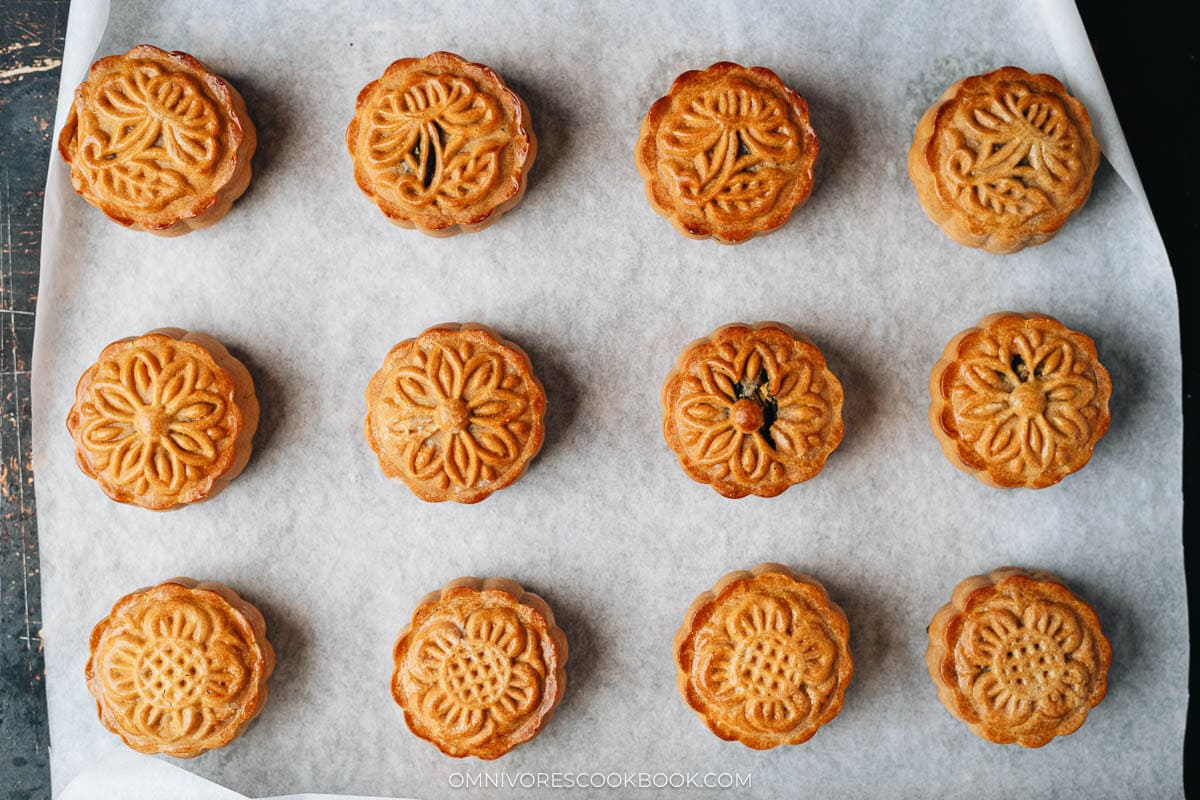
Why is resting mooncakes important?
Resting mooncakes after baking is one of the most important steps for achieving the right taste and texture. This process is called “回油” (huí yóu, “returning oil”), which means to wait for the oil to come out.
Freshly baked mooncakes have a dry, crumbly, and almost cookie-like crust. Resting allows the oil in the dough to migrate outward and the moisture from the filling to move inward, softening the skin into the signature tender, shiny layer. Over a few days, the skin darkens and becomes more golden and glossy, giving the mooncakes a professional look.
The rest period helps the filling and skin meld together. Sweetness, saltiness (from the salted yolk, if used), and aroma become more harmonious, rather than tasting separate.
Typically, Cantonese mooncakes need 2 to 3 days of resting before they’re ready to enjoy at their best. But they usually start to look and taste much better after resting overnight. I always taste them the next day, because I have no patience to wait two days 🙂
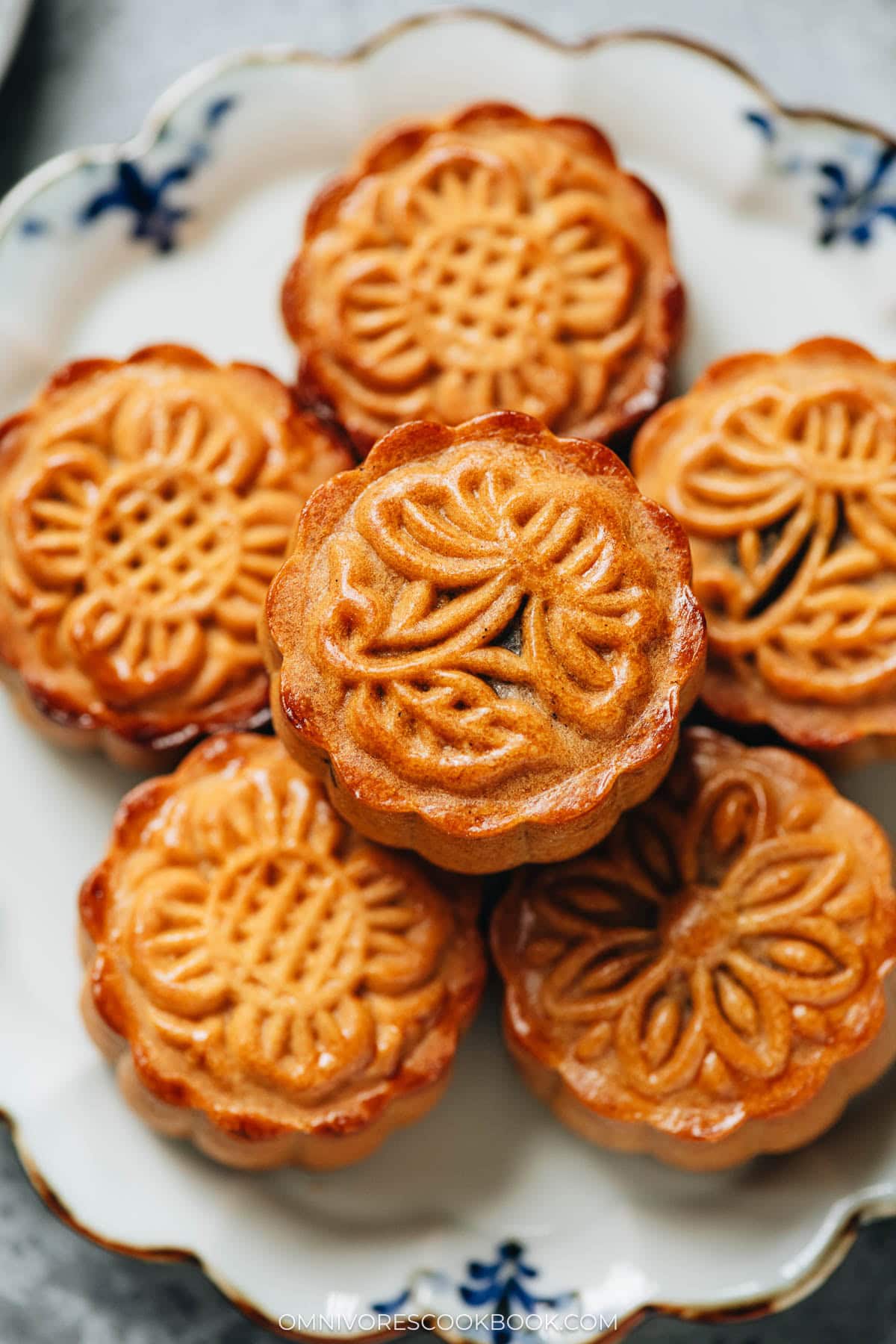
Cooking tips
A scale is the key to success
Making mooncakes requires precision. For the right texture, you will need the correct ratio of flour to golden syrup to kansui. You want to measure the filling quantity so the mooncake has an appropriate proportion of dough to filling. Volumetric measurement and eyeballing simply will not cut it for this recipe.
Be flexible on temperature and baking time
Different ovens will vary in their temperature consistency. I’ve baked mooncakes at 400°F (200°C) and 350°F (176°C), both with good results. I found it best to bake first at a higher temperature for the dough to set, so I can brush the egg wash on easily. Then reduce to a lower temperature to bake evenly and further develop the color. Keep an eye on the mooncakes while baking. If the mooncakes start to develop color too quickly, you might want to reduce the baking time. If the mooncake does not develop color towards the end of cooking, consider raising the temperature back to 400°F (200°C).
Serving and storage
Let the mooncakes rest for 24 to 72 hours after baking. Flavor and texture improve with time.
Store in an airtight container at room temperature if possible, and eat them within a week. Refrigeration can alter their texture.
If freezing, wrap them well and store them in the freezer for up to two months. Thaw them in the fridge slowly, and let the mooncakes return to room temperature before serving.
Frequently asked questions
Do I need to cook the salted egg yolks separately first?
If the salted duck egg yolks you bought are the cooked type, then you don’t need to cook them first. If using raw yolks, you will need to bake them at 350°F (176°C) for 8 to 10 minutes to cook them through before using. Some recipes suggest baking cooked yolks to get rid of the gaminess, but I found that unnecessary.
Can I make the black sesame paste filling in advance and freeze it?
Yes you can! It’s best to freeze the sesame filling after you shape it into balls. So you can directly wrap the mooncakes without thawing the filling. It works beautifully because frozen filling is much easier to work with. If the sesame filling is very frozen (unlike the 30-minute freeze in this recipe), you might want the assembled mooncakes to thaw a little bit before putting them into the mold and shaping them.
Why did my mooncakes crack during baking?
It’s a common practice to spray water onto the mooncakes before baking, to prevent them from cracking. Cracking happens when the dough is not elastic enough. It might happen if you don’t use enough liquid, the flour contains too much gluten, or if the mooncakes are left out too long before baking. Another cause can be because the filling is too wet – especially if you try to make the filling with other ingredients such as sweet potato.
Can I use another type of oil instead of vegetable oil?
Peanut oil works well because it adds nuttiness that works with black sesame filling. Other neutral oil such as sunflower oil will work too.
Can I make mooncakes with chicken eggs?
Yes you can! You can cure chicken egg yolks with salt and sugar. Once cured, the yolks will solidify and can be used in this recipe. Chicken egg yolks are also smaller, so you might be able to fit one yolk into a mooncake instead of halving it, if the yolk is under 10 grams.
Do I have to wait 24 hours to eat these? Or is it possible to eat them straight away?
You can eat them straight away, but you might be disappointed with the texture. The mooncake skin will be rather tough and crumbly, and a little dry. Just so you know, I always taste one straight away because I can’t wait. But the mooncakes start to taste noticeably better on the third day.
Final thoughts
Traditional Cantonese mooncakes are exquisite when done right, not just for their ornate appearance, but also for the harmony of sweet, salty and savory umami. It will take a little practice and patience to make them nicely, but the result is definitely rewarding. Even with boxes of them for sale everywhere this season, homemade mooncakes offer qualities often lost in commercial production. You can taste the freshness of the ingredients and notice a much better depth of flavor. I also like homemade mooncakes because they are less sweet and not as heavy as the commercial type. Lastly, an edible gift made with your own hands is always more special.
If you’re interested in learning about other types of mooncakes, check out my Snow Skin Mooncake with Custard Filling and Pastry Mooncake with Salty Egg Yolk.
Happy Mid-Autumn Festival and I hope you enjoy these homemade mooncakes!
Chinese Cooking Made Easy
Are you new to this website? This free email series is a great place to start. I’ll walk you through a few of my most popular recipes and show you how and why they work. You’ll quickly start to cook better Chinese food in your own kitchen.
Watch video
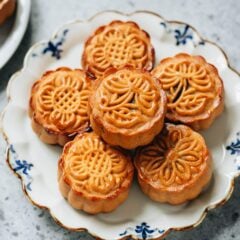
Traditional Mooncake (传统广式月饼)
Ingredients
Mooncake filling
- 140 g (1 1/3 cups) black sesame seeds , toasted
- 80 g (2/3 cup) fine white sugar
- 60 g (4 tablespoons) butter
- 150 g (1 cup) white beans , well drained
- 1 tablespoon maltose (Optional)
- 9 salted duck egg yolks , halved (*footnote 1)
Mooncake dough
- 140 g golden syrup
- 4 g (3/8 teaspoon) kansui
- 50 g vegetable oil
- 1/8 teaspoon salt
- 200 g cake flour
Egg wash
- 1 egg yolk
- 1 teaspoons milk (or water)
Equipment
- 50g mooncake mold
- Scale (*Footnote 2)
- Pastry brush
Instructions
To make mooncake filling
- Add the black sesame seeds into a food processor. Blend until the sesame seeds start to seep oil and thicken, about 2 minutes. Use a spatula to thoroughly scrape the paste from the walls and bottom of the food processor. Blend again until it forms a fine paste, 1 to 2 minutes. Scrape the paste from the walls and bottom.
- Add sugar and white beans. Blend again until everything is fully mixed. If the paste is too thick to blend, you can add a very small amount of water. Transfer the paste to a bowl.
- Heat half of the butter in a medium-sized skillet over medium heat until melted. Add the bean paste. Cook and stir until the butter is fully absorbed. Add the rest of the butter and cook until fully absorbed. Add the maltose if using. Cook and stir until the paste becomes quite dry and able to hold its own shape, 3 to 4 minutes. Transfer the sesame paste to a plate and spread it out. Let cool completely. You can store the sesame paste in the fridge to make it easier to handle later.
To make mooncake dough
- Combine golden syrup, kansui, vegetable oil and salt in a large bowl. Mix with a spatula until emulsified.
- Add cake flour into the bowl. Gently fold the dough with a motion of scraping from bottom to top, like you are folding a cake dough. Do not stir the dough in a circular motion. It will toughen the dough.
- When the flour is fully combined, shape the dough into a ball with your hands. The dough should be soft and a bit sticky but still hold its shape. Seal with plastic wrap. Let rest for 2 hours.
Measure the mooncake filling and dough
- Once it has cooled off, divide the sesame paste into 30-gram portions if not using duck egg yolks. Or add half a duck egg yolk and some sesame paste onto a scale, so that it weighs 30 grams in total. Shape the sesame paste into a ball, then press the center to form a disk. Place the egg yolk in the center. Wrap the sesame paste around the yolk until fully covered, then shape it into a small ball. Place it onto a tray,
- Once you have shaped all the mooncake fillings, cover them with plastic wrap and place them in the freezer. Wait until the balls harden so they’re easier to handle, 30 minutes or so. (*Footnote 3)
- Once the mooncake dough is rested, scoop and measure 20g dough pieces. Shape each dough piece into a ball using your hands. Then place them onto a large tray. Cover the tray with plastic wrap to prevent the dough from drying out.
To assemble mooncakes
- Preheat oven to 400°F (200°C). Line a baking sheet with parchment.
- Place a dough piece onto your palm and use your thumb to flatten the dough from the center, until it forms a round disk that is thinner in the center and thicker on the outside. Place the black sesame filling in the center. Carefully wrap the dough around the filling. Spread the dough until it seals the filling in completely. The dough should be very soft but not sticky, and easy to shape, like soft clay. (*Footnote 4) If you find the dough too thick in some spots, pull off the dough and smooth the surface. It doesn’t matter if the dough is so thin that it reveals the color of the filling. Roll the dough between your hands until the dough forms a smooth ball.
- Slide the plastic pattern disc into the mooncake mold, pattern side down. Twist the handle to lock the pattern disc so it’s secure.
- Dust both hands and the mooncake dough with a bit of cake flour, so it’s easy to release from the mold. Carefully place the mooncake into the mold.
- Place the mold on a clean working surface and firmly press the handle until you cannot move it any further. Hold the handle down for at least 5 seconds so the pattern sticks. Then release the mold from the table and push the handle to release the mooncake onto the lined baking sheet. Work on the rest of the mooncakes and place them onto the tray, about 1” (1.5 cm) apart. Spray a very small amount of water onto the mooncakes to prevent the dough from cracking. Bake for 5 minutes until the patterns are set. The edges of the mooncakes should turn pale golden.
- Meanwhile, make the egg wash by beating the egg yolk with milk (or water) in a small bowl.
- Remove the mooncakes from the oven. Brush a thin layer of egg wash onto the surface of the mooncakes. Only brush the top surfaces, not the vertical (side) surfaces. Try to only brush it onto the arched pattern, and not the recessed concave area. If you accidentally brush too much egg wash and it fills in the pattern, use a small brush to clean the gaps and remove the excess egg wash.
- Place the mooncakes back in the oven and lower the oven temperature to 350°F (176°C). Continue baking until the egg wash turns golden brown, 12 to 15 minutes.
- Let mooncakes cool on the tray for 20 minutes before removing (*footnote 5). Then transfer to a plate to cool completely.
- Once cooled completely, store the mooncakes in an airtight container. The mooncakes can be served after 24 hours, and they will look and taste better after 2 days. (Footnote 6)
Store
- Store the mooncakes in an airtight container in a cool dark area for up to 1 week, or in the fridge for 2 to 3 weeks, or in the freezer for up to 2 months. If stored in the fridge, let the mooncakes return to room temperature before serving. Thaw frozen mooncakes in the fridge overnight before serving.
Notes
- To make black sesame mooncakes without egg yolk, double the black sesame filling and you will be able to make 18 mini mooncakes.
- Mooncake making requires precision and you have to use a food scale to measure the ingredients. Using volumetric measurement won’t be accurate enough and your mooncakes might not come out nicely if you go by volume.
- Sesame filling is not as sticky as other mooncake fillings, such as lotus seed and red bean paste. That’s why I prefer to chill the filling in the freezer before wrapping, so the filling hardens up.
- If your dough turns out too tough to shape with your hands (usually happens if you use all-purpose flour, which contains more gluten and makes a tougher dough), you can do this instead: Place the dough between two pieces of parchment. Press it into a flat disc. Roll it into a small round sheet. It should be fairly easy to wrap the dough using the dough sheet. If the dough sheet breaks off, you can easily patch it onto the filling until the filling is fully covered.
- The mooncakes will be flaky and soft when hot. If you remove them right after baking, the cakes will crush easily.
- The process is called 回油 (Hui You), a process whereby the oil from the filling releases into the dough, making the mooncake dough softer. The mooncake will look a little dry immediately after baking, but will look moist and tender after a day or two. The patterns will also have a rounder, nicer look.
Nutrition

Did you make this recipe?
I’d love to hear how it turned out for you! Please take a moment to leave a 5-star rating ⭐️ and share your thoughts in the comments further down the page. It really helps others discover the recipe too.
This recipe was originally published in September 2015 and was updated in September 2025 (wow it has been 10 years!). In the updated version, I did a few things differently:
- I used commercial golden syrup and kansui instead of the homemade type. Compared to 10 years ago, both ingredients are more available and it’s easy to purchase them online. I recommend using the commercial type instead of homemade, if possible. Because the acid level in the syrup and alkaline level in the lye water are not precise when you make them at home. Using the homemade versions might result in cracked mooncake dough.
- Instead of using glutinous rice flour, I used white beans in the filling as a binder. The beans improve the mooncake texture and make it smoother.
- The new recipe has a slightly improved dough texture that is easier to work with.
- I updated the shaping method and baking temperature, so the mooncakes look better.

Josephine
Enjoyed your writing, never mind if its a little ‘long winded’. Its necessary me thinks and i use your writing as a reading material for my 14yo … she learns so much more!
Thank you for sharing and writing.
BE IN HEALTH!
Nataly Novak
Thank you so much for the article! However I wonder how can you make the salty eggs and if something similar can be done with chicken eggs, as in my country this is the hardest ingredient to obtain, it seems.
Thank you in advance!
Sarah Ariffin
Hi Maggie,
I was looking for some homemade traditional mooncake recipe and found yours.. It’s exhilarating to know that your recipe has undergone a thorough testing and that makes me to want to make it even more.. just one question though about the size of the mooncake.. do you have an exact weight in grams for the dough and filling used per mooncake for the mould that you are using.. 50 – 55 gm mould if i’m not mistaken right? .. thanks!
Maggie
The filling is about 30 grams but I don’t have the measurement for the dough. Yes, I did use the 50gm mould.
hướng dẫn làm bánh trung thu
I still remember the taste of the grilled mooncake when I was a child. Traditional mooncakes are so delicious. Thanks for the recipe.
Maxene
I made my own kansui and syrup following your recipe, but I found the dough was very crumbly! Do you have any suggestions for this?
Vivian Kam
May I ask, do I have to wait 24 hours to eat these? Or is it possible to eat them straight away?
Maggie
Hi Vivian, you can eat them straight away but they will taste better after waiting for 24 hours.
Fabio Consonni
A big big THANKYOU Maggie for these >4000 words.I’ve read them a lot of times. I love to understand why things happen, so to be able to adjust processes by my own: and that’s why I love what you did by giving us the gift of your exspermentation. I could make my first 6 mooncakes (125g each) understanding the whys of what was happening. I filled them with ground boiled barley with vanilla aroma, with african yam paste, with red adzuki paste, with red adzuki and chinese pork floss for a salted filling version (i’m an experimenter too).
Now, as an experimenter, I’m going to try to obtain a salted version of the skin, for a mooncake where sugar is not involved. I’m already used to Jian sui as an ingredient for ramen noodle process, so I’m going to experience in that field. I’m trying with all-purpose and strong flour to get the difference. Do you know any recipe for salted mooncake skin?
Molly
I made these this week after many weeks of reading up on mooncakes! I ended up substituting a lot of things – I used raw honey instead of golden syrup and baking soda mixed in water instead of baked soda. I like the lighter look rather than the dark look, so mine turned out perfectly for me! The only thing I wish was a bit different was the filling was a bit too dry. It tastes great but the oil didn’t soak into the outer dough even after many days. Perhaps I will just add more butter next time! Thanks again for the super detailed information!!
Michael Tan
very good. Hope to try it one day!
Sarah S Halverstadt
My husband cracked open a moon cake tonight. I picked up the little cake to exam its shape and color. Then my husband sliced it and I wondered how it was constructed so that the egg and lotus seed filling where encased within a thin pastry so perfectly. Thank you for a wonderful description and recipe with photos! Inspiring.
Krystal Pagel
Love this post! And your cooking notes! Details are so important 😍
Kristen
My friend and I used your recipe to make mooncakes this year and (most of them) turned out great! We used 100g molds and were able to scale up your recipe to fit. Thank you for developing and sharing this guide for homemade mooncakes. Although, it did takes us closer to 12 hours over 2 days to finish. We also winged a red bean filling but forgot to add oil, so we ended up with a few “marbled” mooncakes…still tasty though!
Pick King Chiew
Thanks so much foryour very detailed information on making mooncakes. Definitely helpful!
Vesna
Hi Maggie. I cooked mooncakes for the first time using your recipe. They’ve turned out to be delicious! Can I ask though for how long they can be stored? I have stored mine outside the fridge for 48 hours. Will they last for 72 hours outside the fridge or should I have refrigerated them? The temp in my house is about 20 degrees. Thanks.
LilD
Holy cow! I don’t know if I’ll ever get to make this, but it’s still amazing! Thank you for sharing.
Luis
Hi Maggie,
I am trying to make my own homemade mooncake but stumble with a problem that my filling becomes flaky after baking instead soft and greasy, also the filling doesn’t stick to the skin. Its separate easily when you cut the cake.
I am using 1 kg of red bean, 500gr sugar, 600gr peanut oil.
I made this as a project with a group of friends so we have to put the filling on fridge for weeks as we plan to make 200 pcs and share it between us.
The try out doesn’t look good, so do you have recipe for red/mung bean paste I can follow?
Any sugestion why my filling not attached to the skin ?
I read your reply and guess the we did not ground the beans long enough to let the oil comes out and cause it flaky, is it correct ?
Thanks so much for the article, it really help us to made my project easier.
Luis
Stephanie F.
THANK YOU!!!! I am a non-Asian attempting to make mooncakes from scratch and this was incredible! My children are homeschooled and are reading Grace Lin’s book The Starry River of the Sky. As part of our extension of the book we decided to attempt mooncakes from scratch, which led to so many rabbit holes and cultural excursions! After a quick and unyielding trip to a large Asian market we could not get kansui or golden syrup (or couldn’t find it!) so we set off to figure out how to make them ourselves and your post was a lifesaver! Without it we would have been stopped in our tracks. All the necessary scientific explanations were there so that we could truly understand the chemistry and it even led to further explorations in chemical reactions. What a joyful labor it was to attempt and appreciate the complexity and love it takes to make these delicious cakes. I know this will be a memory for our family that will last a lifetime. Thank you.
Maggie
Hi Stephanie, thanks so much for taking time and leaving a comment! I hope you enjoy the mooncakes. It’s INDEED a labor of love. I took me forever to test the recipe, but I was so happy I did it. The mooncakes turned out 10 times better than our usual store bought ones. I hope you liked the result as much as I do 🙂
Monique
Thank you so much for the time and effort you have put forth to come up with this recipe. I would love to try to make this traditional treat. I have Chinese co-workers who brought mooncakes into the office one year and I fell in love. I cannot imagine a mooncake without the salted egg yolk.
I haven’t been able to buy any because they are so expensive! However, after reading this I think it would be better to make them myself. I am a bit hesitant, because I don’t know if I’m up to the task.
Vusala Aranjo
Maggie! I’m so happy I came across your website! This is a gem! Thank you so much for all the knowledge you’ve shared here! I stared making mooncakes and come out pretty well but I want to perfect them and your site is exactly what I needed. I can’t tell you how grateful I am for all the information you have shared! Thank you for the bottom of my heart and mybusbamf belly who’s crazy about Koo cakes!
Maggie
Thanks so much for taking time to leave a comment and your kind words! I’m so happy to hear the post is helpful.
Happy cooking and hope your mooncakes turn out perfectly 🙂
Jeff Leonarx
Really great of you to supply real detailed information. You have saved me a lot of time! Thank you so much!
Jeff Leonard
Leonard, not leonarx. Lol.
Barbara Todd
Thank you for your beautiful post. I have 2 Chinese daughters from Beijing. YuXi has been with us 2.5 years and XiaoLi 1 year. They were adopted from the same China home (orphanage). As YuXi was born with no ear canals, her hearing and language, both Mandarin and English are delayed but improving with her hearing devices. XiaoLi speaks great Mandarin and wonderful English but working on Pinyon and spelling and reading. YuXi is 11 and XiaoLi is 12. They go to weekly Chinese school and they are celebrating the mid autumn festival there today. I have wooden Mooncake molds and would like to attempt to make some. I would like to subscribe to your site as I know your heart and love is included i. Your recipes. Will let you know how the turn out.